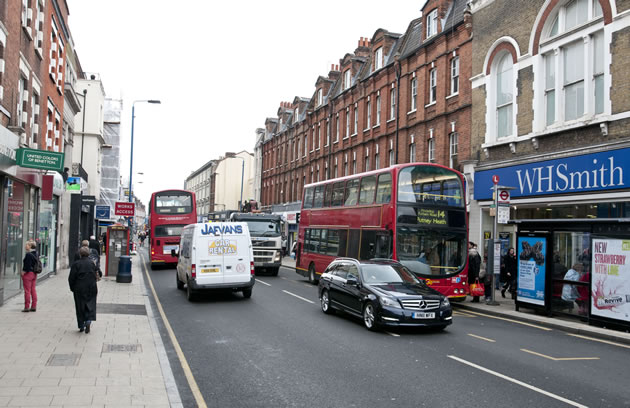New survey shows pollutants still exceeding mandatory safe limits

|
Ahead of Clean Air Day 2018, a new snap shot survey of air pollution in Putney has found that there are still significant problems with Putney’s air quality,
75% of locations tested by the Putney Society show readings that exceed EU recommended safe levels of nitrogen dioxide (NO2), with levels at seven of the locations more than 20 per cent over the mandatory safe level.
The tests show there has been a significant reduction in measured NO2 levels since a similar survey was undertaken by the Society in 2016, mostly probably a consequence of TfL’s introduction of cleaner hybrid buses along Putney High Street in early 2017. These results broadly mirror those from Wandsworth Council’s monitoring sites.
Within the first 8 days of 2016 Putney High Street became the first area in London to breach annual EU NO2 levels and by the end of 2016 there had been nearly 1300 separate breaches of EU air limits. Last year Putney High Street was designated by the Mayor as a bus ‘green’ route and breaches fell to just below 100 incidents. The latest survey results confirm that while there have been welcome improvements in local air pollution problems the average Putney reading, when compared to the Society’s 2016 survey, is still 25% above the EU “safe level”.
Levels near some schools in Putney were high: EU levels were breached in two out of four locations tested – in one case, on Putney Hill outside Putney High School, it was almost double the EU “safe” level.
Some research suggests exposure to NO2 leads initially to respiratory problems but can lead in the longer term to permanent lung damage and heart problems and ultimately a shortened lifespan. In children exposed to poor air, lungs may never develop properly, which is incurable. Air pollution experts at King's College London estimate that the total number of premature deaths from NO2 and particulates is between 3,500 and 9,500 a year in London.
Almost two thirds of NO2 in London’s air according to the Mayor’s Office, come from road transport, almost half of that from diesel engines. Both Transport for London (TfL) and Wandsworth Council have introduced a number of policies to attempt to address the problem. These include TfL’s introduction of more hybrid buses and the planned expanded Ultra Low Emission Zone (ULEZ) up to the North and South circular roads to reduce pollution to acceptable levels by 2021, while locally Wandsworth Council has developed an air pollution strategy, maintained regular air monitoring in the High Street, lobbied for less polluting buses and restricted day time loading for lorries in Putney High Street.
Robert Arguile, Chair of Putney Society said: “Our research confirms that, despite very welcome improvements, there are still high levels of NO2 in central Putney. We broadly welcome Mayor Khan’s plan to extend the ULEZ to areas inside the North and South Circulars from 2021 and look forward to the full details.
He continued: "The proposed ULEZ will need to be tightly controlled. All vehicles breaching EU limits in real road tests, not the laboratory ones, which are too easily cheated, should be banned from the extended ULEZ.”
June 22, 2018